water temperature
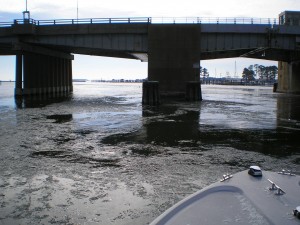 Catching striped bass in winter on the Chesapeake Bay isn’t easy. It’s not that the fish aren’t around because there are some to be caught. It’s just that it’s very hard to get to them. We’ve had an exceptionally cold December followed by multiple sub-freezing days in January. It’s also been very windy. The windows of light-tackle opportunity are frosted. Even on rare days when the weather is fishable it’s a challenge to get on the water because the boat launches around Kent Island have been iced in solid. Fortunately, we got a little warming trend this week, so a few ramps opened up. Read More!
Catching striped bass in winter on the Chesapeake Bay isn’t easy. It’s not that the fish aren’t around because there are some to be caught. It’s just that it’s very hard to get to them. We’ve had an exceptionally cold December followed by multiple sub-freezing days in January. It’s also been very windy. The windows of light-tackle opportunity are frosted. Even on rare days when the weather is fishable it’s a challenge to get on the water because the boat launches around Kent Island have been iced in solid. Fortunately, we got a little warming trend this week, so a few ramps opened up. Read More!
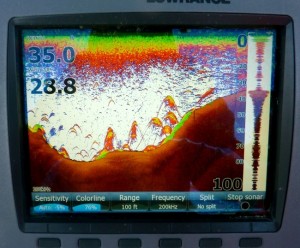 To fizz or not to fizz, that is the question a lot of yellow perch fishermen have been asking lately. As you can see by this sonar shot, yellow perch can hold in a wide range of depths this time of year in the Chesapeake Bay. At issue is that a few of the fish we catch from the deepest water come up with distended swim bladders. Since we inevitably land a few that are under the legal size limit, they have to be released. Because of all the air in their bodies, they can’t always swim back down. This leaves them floating on top of the water where they are vulnerable to birds and other predators. The practice of puncturing a fishes swim bladder with a hypodermic needle or other sharp object to relieve pressure is called fizzing. It works for some species, but for others it isn’t such a good idea. What about yellow perch? This week, I put the question to the experts. I spoke with several fisheries biologists I know, including some at the Maryland Department of Natural Resources. Here’s what I learned. Read More!
To fizz or not to fizz, that is the question a lot of yellow perch fishermen have been asking lately. As you can see by this sonar shot, yellow perch can hold in a wide range of depths this time of year in the Chesapeake Bay. At issue is that a few of the fish we catch from the deepest water come up with distended swim bladders. Since we inevitably land a few that are under the legal size limit, they have to be released. Because of all the air in their bodies, they can’t always swim back down. This leaves them floating on top of the water where they are vulnerable to birds and other predators. The practice of puncturing a fishes swim bladder with a hypodermic needle or other sharp object to relieve pressure is called fizzing. It works for some species, but for others it isn’t such a good idea. What about yellow perch? This week, I put the question to the experts. I spoke with several fisheries biologists I know, including some at the Maryland Department of Natural Resources. Here’s what I learned. Read More!
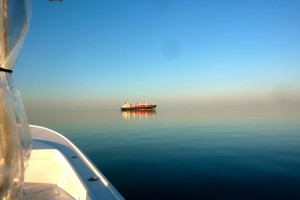 It’s been a windy December, so rough lately that it’s been hard to get out and fish. After yet another strong nor’easter blew through this week, the wind finally came down. Hoping for some cold weather catch & release action, my son Daniel and I broke the ice Wednesday and launched Thunder Road at the Shipping Creek ramp on Kent Island to do some Mid-Bay exploring. We didn’t find many fish – one twenty-four-inch striper to be exact – but we enjoyed our time on the water. The Chesapeake was as flat as I’ve ever seen it. We could see for miles across the glass. In places where we could get an unobstructed view of the horizon, we couldn’t tell where the water ended and the blue sky began. I’ve noticed that the waters of the Bay seem calmer and bluer on cold winter days. Sometimes I think I can see farther this time of year. It turns out there’s an interesting scientific explanation. Read More!
It’s been a windy December, so rough lately that it’s been hard to get out and fish. After yet another strong nor’easter blew through this week, the wind finally came down. Hoping for some cold weather catch & release action, my son Daniel and I broke the ice Wednesday and launched Thunder Road at the Shipping Creek ramp on Kent Island to do some Mid-Bay exploring. We didn’t find many fish – one twenty-four-inch striper to be exact – but we enjoyed our time on the water. The Chesapeake was as flat as I’ve ever seen it. We could see for miles across the glass. In places where we could get an unobstructed view of the horizon, we couldn’t tell where the water ended and the blue sky began. I’ve noticed that the waters of the Bay seem calmer and bluer on cold winter days. Sometimes I think I can see farther this time of year. It turns out there’s an interesting scientific explanation. Read More!
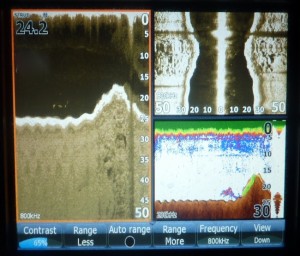 Back when I was a kid tramping through the woods of East Tennessee, I looked for the underground dens of rabbits, chipmunks and woodchucks. Now days, I’m stalking fish instead of varmints, but I’m still hunting for hidey-holes. It’s the time of year when Chesapeake Bay striped bass hunker down in deep, warm-water hideouts. It takes patience and persistence to catch them but if you aggravate them long enough, you can sometimes get them to bite. The trollers are still picking off a few big cows around the channels, but it’s tough to get isolated fish on a jig. From now until the first of the year I’ll be fishing around the bridges and in the deeper water around other submerged structure looking for holed-up rockfish. Read More!
Back when I was a kid tramping through the woods of East Tennessee, I looked for the underground dens of rabbits, chipmunks and woodchucks. Now days, I’m stalking fish instead of varmints, but I’m still hunting for hidey-holes. It’s the time of year when Chesapeake Bay striped bass hunker down in deep, warm-water hideouts. It takes patience and persistence to catch them but if you aggravate them long enough, you can sometimes get them to bite. The trollers are still picking off a few big cows around the channels, but it’s tough to get isolated fish on a jig. From now until the first of the year I’ll be fishing around the bridges and in the deeper water around other submerged structure looking for holed-up rockfish. Read More!
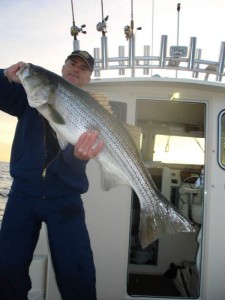 Maybe I’m getting better, but more likely I just got lucky. Either way, I called this last pattern change pretty close. As the water cools, big fish move closer to the main channel of the Chesapeake Bay. There’s still plenty of smaller fish in the rivers and the nearby flats, but since it’s late November and the season for trophies, it’s time to lock in on the channel. Here are two good reasons: Number one – water temperature. Striped bass prefer water that is warmer than 50 degrees. Surface temperatures right now in most of the Maryland section of the Chesapeake Bay are in the low 50s. Since the deeper water near the channel can be ten degrees warmer than it is in the rivers, stripers will stay closer to their comfort zone. You’ll see them holding very close to the bottom on the fish finder. They will still move up shallow to eat, but they’ll go right back to the deeper water to rest between feeding frenzies.
Maybe I’m getting better, but more likely I just got lucky. Either way, I called this last pattern change pretty close. As the water cools, big fish move closer to the main channel of the Chesapeake Bay. There’s still plenty of smaller fish in the rivers and the nearby flats, but since it’s late November and the season for trophies, it’s time to lock in on the channel. Here are two good reasons: Number one – water temperature. Striped bass prefer water that is warmer than 50 degrees. Surface temperatures right now in most of the Maryland section of the Chesapeake Bay are in the low 50s. Since the deeper water near the channel can be ten degrees warmer than it is in the rivers, stripers will stay closer to their comfort zone. You’ll see them holding very close to the bottom on the fish finder. They will still move up shallow to eat, but they’ll go right back to the deeper water to rest between feeding frenzies.
The second reason to fish near the channel is bait. Larger fish want bigger bait. The most common baitfish of any consequence in the Bay right now is menhaden. Since they migrate toward warmer water just like rockfish, by late November they are well on their way toward their comfort zones farther south. That means there is less and less bait in the upper reaches of the Bay and the biggest concentrations of menhaden are now near the channel. That’s perfect conditions for big stripers because they can hang out in the deeper warmer water and still ambush big bait. That doesn’t mean they’ll bite anything you throw at them though. Well, maybe the smaller fish will, but there’s a secret to getting the trophies. Read More!
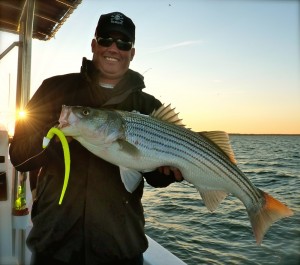 This week I’ve been fishing both north and south of Kent Island. I’m running along the deeper ledges looking for big birds either diving on breaking fish, flying high, or sitting. Since the fall turnover, the better fish have been feeding deep, sometimes thirty five feet deep or more. Once they round up a school of four to six inch bunker, they force them to the surface then explode into them knocking the hapless baitfish into the air where the gulls are waiting. The fish aren’t breaking in big pods but moving around in twenty to thirty fish rat packs. I usually only see a few splashes here and there to send down the birds. The predators move on quickly, so by the time you get to where you saw the splashes, they’re usually gone. The trick to catching them is to figure out what is attracting them to the location and try to anticipate their next move. While migratory stripers will feed wherever they find baitfish, this time of year they’re still running with Chesapeake residents so it’s more likely they are relating to underwater structure. That structure will probably be a live hard bottom near a steep subsurface ledge, especially ledges located near the mouths of tributary rivers. So when big fish are breaking here and there and not really schooled up, the best bet is to simply set up a drift near the ledge and wait for them to come to you. Read More!
This week I’ve been fishing both north and south of Kent Island. I’m running along the deeper ledges looking for big birds either diving on breaking fish, flying high, or sitting. Since the fall turnover, the better fish have been feeding deep, sometimes thirty five feet deep or more. Once they round up a school of four to six inch bunker, they force them to the surface then explode into them knocking the hapless baitfish into the air where the gulls are waiting. The fish aren’t breaking in big pods but moving around in twenty to thirty fish rat packs. I usually only see a few splashes here and there to send down the birds. The predators move on quickly, so by the time you get to where you saw the splashes, they’re usually gone. The trick to catching them is to figure out what is attracting them to the location and try to anticipate their next move. While migratory stripers will feed wherever they find baitfish, this time of year they’re still running with Chesapeake residents so it’s more likely they are relating to underwater structure. That structure will probably be a live hard bottom near a steep subsurface ledge, especially ledges located near the mouths of tributary rivers. So when big fish are breaking here and there and not really schooled up, the best bet is to simply set up a drift near the ledge and wait for them to come to you. Read More!


